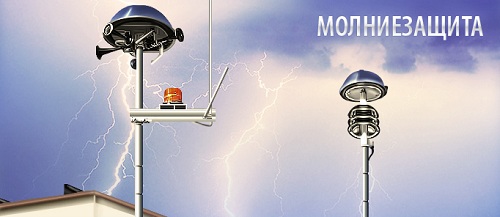
Lightning protection of a metal roof is carried out by using pin or torso lightning rods. Despite the fact that the roof itself can function as a conductor, the receiver itself should be placed on it. But in order for the roof to be used as a lightning receiver more fully, it is necessary that it has reliable electrical contact over the entire surface. Thus, all down conductors must either be firmly welded or bolted to ground elements.
Please note that in the case of grounding, it is necessary to conduct a normalized electrical connection between the sheets of the roof.
In addition, the metal roof must be firmly fixed to the rafters. In this case, the entire rafter system, each wooden element, must be treated with refractory substances. This is necessary because a direct lightning strike into a metal roof can cause a spontaneous fire. The reason is that under the influence of high temperature the roof, and from it the rafter system, become very hot. For less impact of high temperatures on the rafters, a roofing material spreads under the metal roof. This is not too costly economically, but allows you to some extent secure your home.
It should be noted that if a lightning strike enters an element of a metal roof, a burnout or fusion may occur. Thus, if the metal roof is very thin, less than 1 mm, deep fusion can occur. As a result - ignition of both roofing material and the rafter system. Therefore, when choosing a roofing material, it is necessary to pay attention to its thickness and melting characteristics.
Based on all of the above, we can draw the following conclusion:
The connection of the sheets of the metal roof must be very strong, between them it is necessary to conduct an electrical connection, fix them on non-combustible material. In this case, the metal tile will be an air terminal for itself.
Please note that if all the work on grounding the metal tile is not economically profitable, you can install grounded rod or torso lightning receivers.
Content
How to make lightning protection with your own hands
In order to protect the house from ignition, as well as to maintain the working condition of all electrical appliances, it is necessary to build a lightning conductor. A lightning rod consists of two parts: internal and external protection of the house.
Internal protection of the house is necessary to maintain the integrity of the electrical network under the influence of overvoltage from a lightning strike.
External protection is designed to ensure the safety of the whole house from fire.
What is external and internal protection?
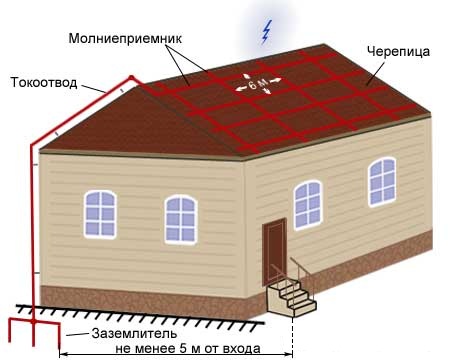
As a rule, this is a lightning rod, a grounding device and a down conductor. As a lightning receiver, use any cone or pin made of a durable metal alloy.
The internal system is to use bit devices for electricity networks designed to limit voltage levels.
The internal system to protect the house from power surges cannot be completely implemented independently.But having certain skills in handling electric wires and electrical appliances, you can build your own finished devices in the network.
Note. If the house is not equipped with a lightning rod and internal protection, during thunder and lightning, it is necessary to disconnect all equipment in the house from the power supply. Moreover, this method is relevant only if the lightning follows the thunder for 10 seconds.
External protection against lightning strikes can be done independently. The process is quick and not too expensive. However, you must have the skills to work with the welding machine.
Thus, you will need a down conductor, an air terminal, an earthing switch, several clamps and brackets made of soft metal, a welding machine.
First of all, it is necessary to connect the down conductor to the rod lightning rod. The air terminal is made of thick iron wire with a sufficiently large cross section.
A ground electrode is made from a strip of metal. Its cross section should be at least 150 sq. Mm. For these purposes, you can use a steel rod. With a diameter of about 18 mm.
All structural elements are connected by electric welding or metal clamps, which are mounted on nuts and bolts.
The grounding system is made not far from the house, 1.5 meters. At what height the grounding will be located depends entirely on the position in which the angle of protection will be 70 °.
How to make lightning protection at home more effective?
Please note that the highest point of lightning removal must be made in the form of a cone. Also, for reliability, you can install multiple lightning rods with one grounding at once.
How to make do-it-yourself grounding
Grounding is made of a metal object of fairly overall dimensions, having a vast area. It should be instilled at maximum depth. So. As an object for grounding, you can use a piece of pipe, a rafter metal angle. Often use a reinforcing mesh of strong and thick wire, or a metal barrel, even a solid thick sheet or piece of iron is suitable.
Please note that it is necessary to bury an object for grounding to a depth that exceeds the depth of freezing of the soil.
How to make grounding more durable?
To increase the conductivity of electricity, holes are drilled every few years, and salt or nitrate is placed in them.
How to make lightning protection with your own hands
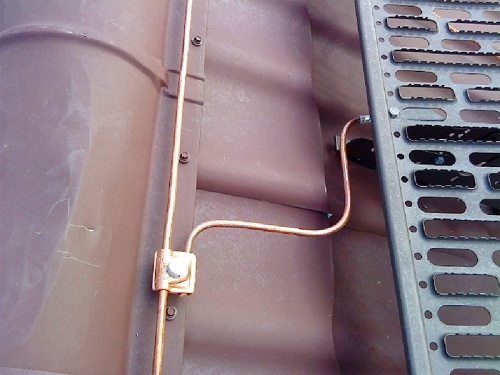
Lightning protection of a metal roof is a bare conductor treated with corrosion protection. As a rule, it is made of thick aluminum or copper wire. You can also use galvanized steel.
Physicists have found that the air terminal protects a certain space, with an area of a cone. The dimensions of this cone depend on the length of the air terminal and the shape of its peak. Thus, depending on how high the wire is raised. The area of the protected space depends. The height must be counted from the highest point in the area to be protected. If this is the roof ridge, it means from the ridge of the roof, if the chimney, then, respectively, from the chimney. If there is a pipe, but it does not pose a threat, since it is not metal, you can fix an air terminal on it to increase the height. It should also be fixed with a conductor and ground. However, keep in mind that the pin, if heavy, can create a solid load. It is necessary that the pipe be firmly fixed.
So, lightning protection of a metal roof, with fastening to a pipe, is carried out as follows:
- masts are installed on the gables, their height should be about 2 meters.
- between them you should draw and pull a thick insulated wire;
- the wire is pulled to ground.
If there is a tall tree near the house, then the lightning rod can be mounted on a long pole.Which, in turn, with the help of clamps, attach to the tree. An excellent lightning rod can be a television or cell tower located near the house. But in this case, it should not be painted.
In the event that the mast is built of wood, a thick wire or a strong bare wire is launched along its length. And connect it to ground. It is also necessary to install a lightning rod on the top of the mast, and connect it to the wire - conductor.
How is the height of lightning protection calculated
In order to make the calculation of the so-called “passive” protection, you need to know what type of structure, what height, length and width of the building. What is an object: a linear-long or a single structure.
It is also necessary to establish the approximate number of annual lightnings coming per 1 square meter in a given region. Detailed data can be found in the Hydrometeorological Center. It is from these values, according to the level of danger, that the height of lightning protection is determined.
So, we will describe what in the end should be a lightning protection design.
As we have already said, the entire structure will consist of the following elements:
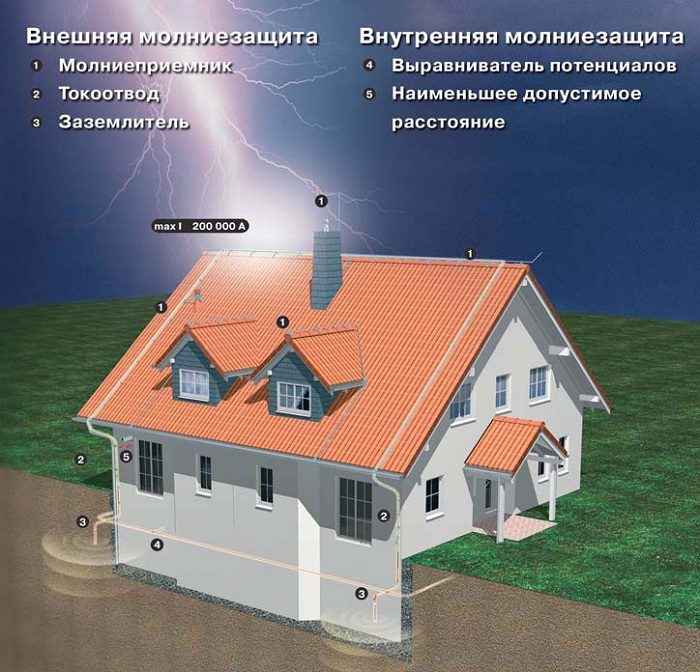
Lightning rod, ground electrode and conductor, i.e. lightning rod.
The air terminal should consist of a thick galvanized wire, which is mounted on the highest part of the house, that is, on the ridge or pipe. The conductor, made of the same thick wire, must connect to the air terminal and go down to the ground electrode. Often, the conductor is attached to a drainpipe or to the wall of a house. Mounting is carried out using metal clamps.
Note, to the wall of the house, the lightning rod is mounted at a certain distance, on special racks. If the house is wooden, then the length of the racks should be at least 10 cm, if the wall is brick or of other non-combustible material, then the length of the racks is about 5 cm.
The earthing switch is located at a frost-free depth. For each region, this indicator is individual. The distance from the house is at least 1.5 meters.
Features of receiving lightning
For a more accurate installation of the air terminal, it will not be superfluous to know the following nuances:
- Objects located at high altitude attract lightning discharges not only above the apex, but also from the peripheral sides of a thundercloud.
- The most effective lightning rods made of cable objects. The use of the grid does not give great guarantees of protection.
- Remember that television antennas cannot be lightning rods. And it does not matter on which mast they are mounted, metal or wooden. But if they are not far from the lightning rod itself, part of the shock of electricity can pass onto them.
- It is undesirable to attach the air terminal to the antenna. Due to non-compliance with equopotentiality, a short circuit under the roofing material may occur in the antenna wires.
- At the moment of approaching the electric charge of lightning to the ground, the electric field is amplified, both at the surface of the earth and at the top of the building.
- If the metal roof itself is a lightning conductor, you must make sure that the electrical continuity between its elements is ensured for a long time.
- If several lightning rods are used at once, they should be located at a fairly large distance from each other. If there are more than two, then they must create a network, or as they say "Faraday Cage."
In conclusion, it should be noted that all the rules for the manufacture and installation of lightning protection elements must be observed exactly.
Independent erection of a lightning protection system - does not present difficulties. Observing the safety rules, as well as the installation conditions for all lightning protection elements, as a result you will get a completely reliable building.

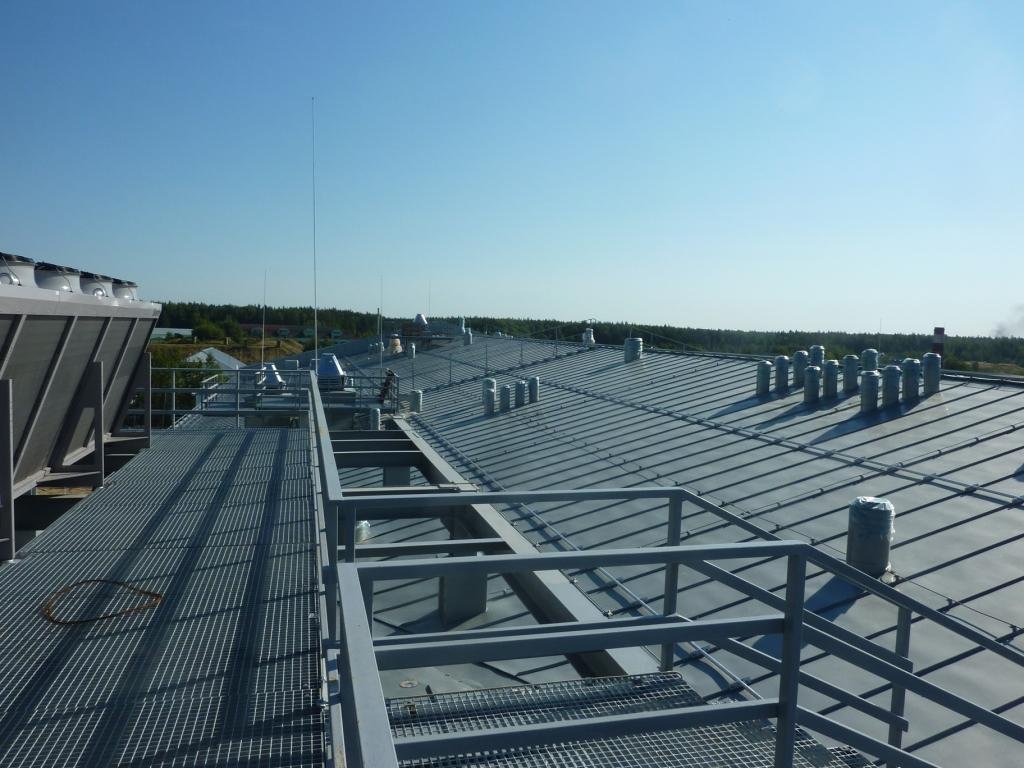



Alas, no comments yet. Be the first!